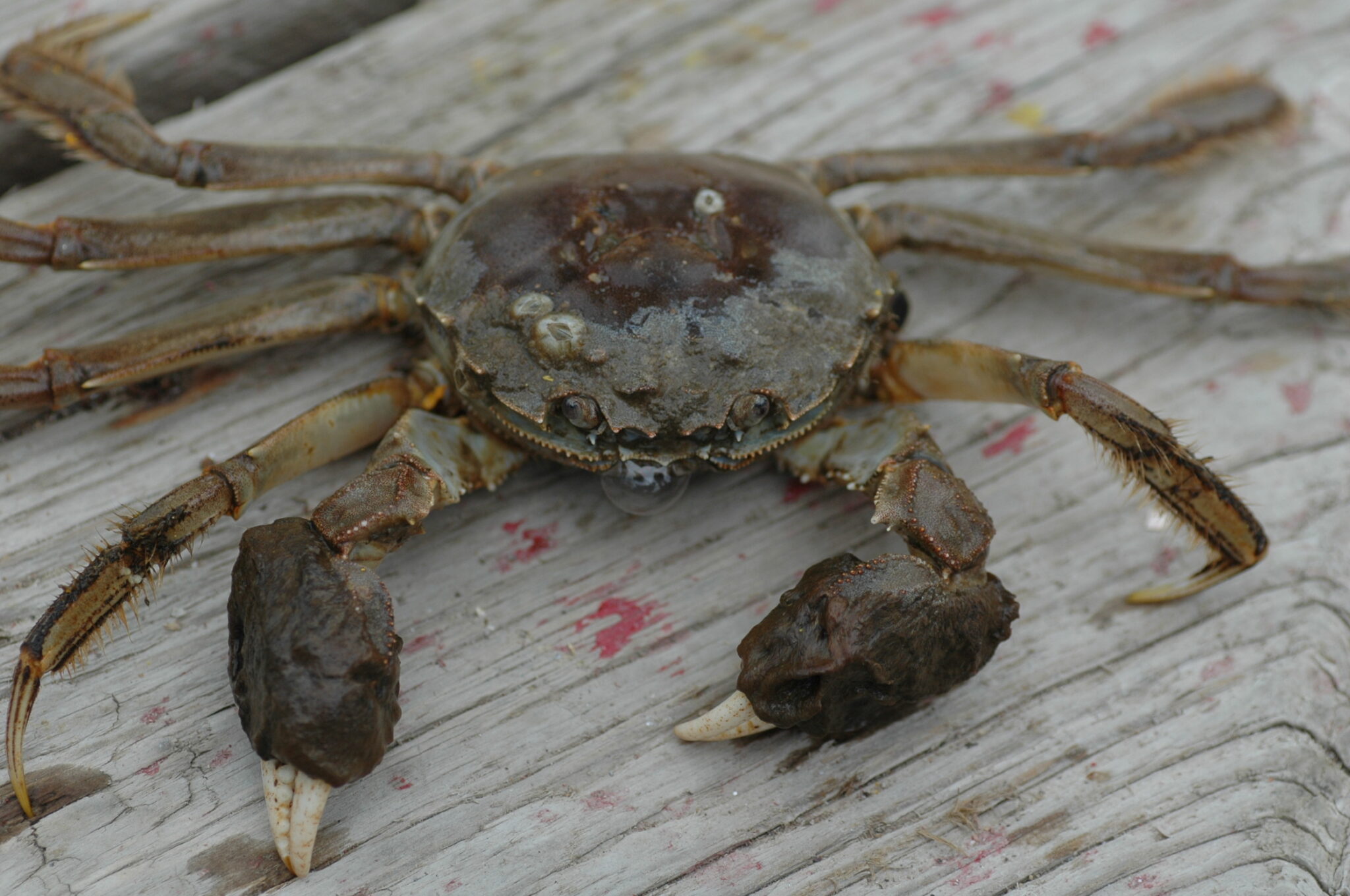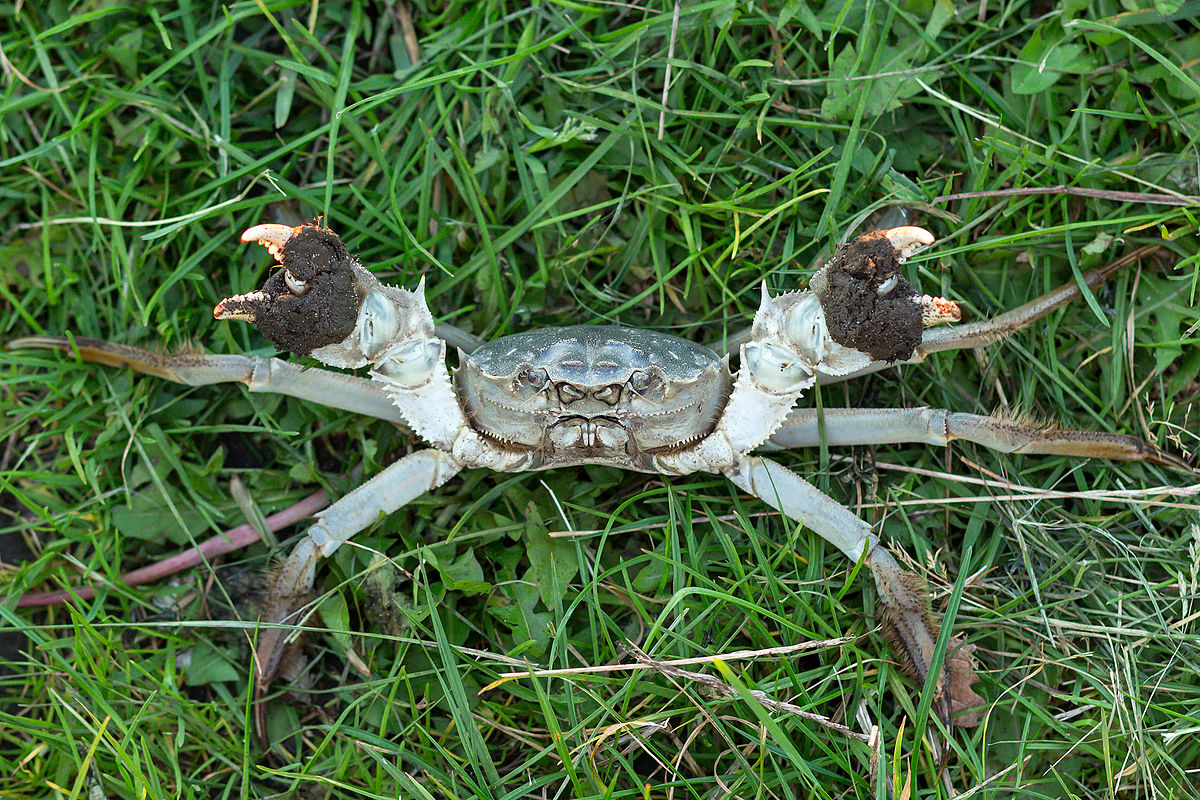Taxonomy and Biology: Chinese Mitten Crab

The Chinese mitten crab, Eriocheir sinensis, is a fascinating crustacean species belonging to the family Varunidae. Its scientific classification is as follows:
- Kingdom: Animalia
- Phylum: Arthropoda
- Subphylum: Crustacea
- Class: Malacostraca
- Order: Decapoda
- Family: Varunidae
- Genus: Eriocheir
- Species: Eriocheir sinensis
Physical Characteristics
Chinese mitten crabs exhibit distinct physical characteristics. Adult crabs typically measure between 3 and 8 centimeters in carapace width, with males being generally larger than females. Their bodies are characterized by a hard exoskeleton, which is typically a brownish-green or olive color. The carapace, or upper shell, is broad and slightly wider than it is long. It features a distinctive “H” or “M” shaped pattern on its surface.
Unique Features
One of the most striking features of the Chinese mitten crab is its unique claws. The claws are unequal in size, with the larger one, known as the crusher claw, being used for crushing prey and the smaller one, called the pincer claw, being used for gripping and cutting. The tips of the claws are lined with small, sharp teeth, further enhancing their functionality. The claws are covered in dense hair, giving them a mitten-like appearance, hence the species’ common name.
Habitat and Distribution
The Chinese mitten crab is native to the coastal waters of eastern Asia, including China, Korea, and Japan. It inhabits a variety of habitats, including estuaries, rivers, lakes, and coastal wetlands. The crab prefers areas with soft, muddy bottoms and abundant vegetation, which provide food and shelter.
The Chinese mitten crab, an invasive species that has spread to many parts of the world, is a fascinating creature. Its adaptability and resilience have made it a successful colonizer, but it has also caused problems in some ecosystems. The recent news of the death of the Iranian president in a helicopter crash is a reminder of the fragility of life and the importance of cherishing each moment.
As we learn more about the Chinese mitten crab and its impact on the environment, we must also remember to appreciate the beauty and diversity of the natural world.
The Chinese mitten crab has become an invasive species in various regions around the world, including Europe, North America, and South America. It was accidentally introduced to these regions through ballast water discharge from ships or via aquaculture activities. The crab’s ability to tolerate a wide range of environmental conditions, coupled with its aggressive behavior and high reproductive rate, has contributed to its successful invasion.
Factors Contributing to Successful Invasion
- Tolerance to Environmental Conditions: The Chinese mitten crab can survive in a wide range of salinity, temperature, and oxygen levels, making it adaptable to various aquatic environments.
- Aggressive Behavior: The crab is known for its aggressive behavior, which allows it to compete successfully with native species for food and habitat.
- High Reproductive Rate: Female Chinese mitten crabs can produce up to 1 million eggs per year, contributing to the rapid population growth of the species.
- Lack of Natural Predators: In its invasive range, the Chinese mitten crab often lacks natural predators, allowing its population to grow unchecked.
Life Cycle and Reproduction

The Chinese mitten crab has a complex life cycle involving several larval stages before reaching adulthood. Its life span can vary depending on environmental conditions, but typically lasts around 2-3 years.
Larval Stages
The life cycle begins with eggs, which hatch into planktonic larvae. These larvae drift with the currents for several months, feeding on microscopic organisms. As they grow, they go through several molts, each time developing new features and becoming more crab-like.
Ecological Impacts
The Chinese mitten crab has a significant ecological impact on native ecosystems. It is an aggressive and voracious predator, and it can outcompete native species for food and resources.
The Chinese mitten crab, an invasive species, has been making its presence felt in various parts of the world. Its aggressive nature and voracious appetite have raised concerns among ecologists. Recently, news of an iran helicopter crash highlighted the dangers of natural disasters and the need for preparedness.
While the crab’s impact on ecosystems is a pressing issue, it also serves as a reminder of the fragility of life and the importance of appreciating the wonders of nature.
The crab’s diet includes a wide variety of organisms, including fish, mollusks, crustaceans, and plants. It is also known to prey on the eggs and larvae of other animals, which can have a negative impact on their populations.
The Chinese mitten crab, an invasive species, has become a major concern in many parts of the world. Its aggressive behavior and ability to outcompete native species have raised alarm. While researching solutions to this problem, I stumbled upon an intriguing piece of information about the iran president wiki . This discovery led me to realize that even in the face of ecological challenges, human curiosity and knowledge-seeking can uncover unexpected connections.
The Chinese mitten crab’s impact serves as a reminder that our actions can have far-reaching consequences, emphasizing the need for responsible stewardship of our environment.
Competition with Native Species
The Chinese mitten crab’s ability to outcompete native species for food and resources is due to several factors. First, it is a very adaptable species that can tolerate a wide range of environmental conditions. Second, it has a high reproductive rate, which allows it to quickly establish large populations. Third, it is a very aggressive species that is not afraid to defend its territory.
The competition between the Chinese mitten crab and native species can have a number of negative consequences. For example, it can lead to declines in the populations of native species. It can also disrupt food webs and alter the structure of ecosystems.
Potential Consequences of Invasion on Biodiversity
The invasion of the Chinese mitten crab has the potential to have a significant impact on biodiversity. The crab can prey on a wide variety of organisms, including fish, mollusks, crustaceans, and plants. It can also compete with native species for food and resources. This can lead to declines in the populations of native species and disrupt food webs.
The loss of biodiversity can have a number of negative consequences. For example, it can make ecosystems more vulnerable to change. It can also reduce the availability of food and resources for humans and other animals.
Human Impacts

The Chinese mitten crab has significant economic, ecological, and public health impacts worldwide.
Economic Impacts
The Chinese mitten crab poses a threat to fisheries and aquaculture. Its voracious appetite for mollusks, crustaceans, and fish can decimate local populations, leading to economic losses for commercial and recreational fishers.
Additionally, the crab’s burrowing behavior can damage infrastructure such as dams, canals, and levees. Its burrows can weaken the structural integrity of these structures, increasing the risk of flooding and erosion.
Public Health Concerns
The Chinese mitten crab can also pose public health concerns. It can carry a parasitic lung fluke that can infect humans who consume raw or undercooked crab meat. The fluke can cause a range of symptoms, including coughing, chest pain, and fever.
Management and Control
Managing and controlling the Chinese mitten crab poses significant challenges due to its adaptability and reproductive success. Various methods have been employed to curb its population growth and mitigate its ecological impacts.
Trapping
Trapping is a widely used method for controlling Chinese mitten crab populations. Traps are baited with food or pheromones to attract crabs, which are then removed and either killed or relocated.
Barriers
Physical barriers, such as fences or nets, can be erected to prevent crabs from accessing certain areas or habitats. These barriers are particularly effective in protecting vulnerable ecosystems, such as wetlands and estuaries.
Habitat Modification, Chinese mitten crab
Modifying the habitat to make it less suitable for Chinese mitten crabs can also help control their populations. This includes removing or reducing vegetation that provides shelter and food, as well as altering water flow patterns to create unfavorable conditions.
Challenges
Managing Chinese mitten crab populations effectively faces several challenges. The species’ high reproductive rate and adaptability make it difficult to eradicate or significantly reduce its numbers. Additionally, its ability to disperse over long distances and colonize new habitats complicates control efforts.